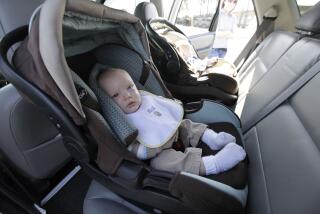Insurance group says car design hinders use of child safety seats
- Share via
Child safety seats are difficult to properly install in cars, according to an insurance industry research group, because of the design of most passenger seats.
Joint research conducted by the Insurance Institute for Highway Safety and the University of Michigan Transportation Research Institute found that just 21 of 98 top-selling 2010 and 2011 model year vehicles have seat designs that are easy to use with child restraints.
The low percentage was notable, considering that the auto industry is using a system called Lower Anchors and Tethers for Children — or Latch — that was intended to make it easier to install the safety seats.
The problem, according to the insurance trade group, is that the manufacturers haven’t paid enough attention to how the Latch system works when designing passenger seats.
“Installing a child restraint isn’t always as simple as a couple of clicks and you’re done,” said Anne McCartt, the insurance institute’s senior vice president for research and one of the report’s authors. “Sometimes parents blame themselves when they struggle with Latch, but oftentimes the problem lies with the vehicle, not the user.”
The vehicles were tested by 36 volunteers, each of whom was asked to install three styles of child restraints in three vehicles. All the participants use child seats in their own vehicles. If they had questions about how to install the seats, they could consult owners’ manuals but received no other assistance.
Only 13% of the volunteers installed seats with lower anchors and top tethers to get a tight, secure fit at the right angle, according to the insurance group.
The researchers found that the lower anchors used to attach the restraint systems were often set too deep in the seats to be easily accessible. Lower anchors — metal tabs that are used to secure the child seat to the vehicle — were visible in just 36 of the 98 study vehicles. Researchers also found that seat belt buckles, bolstering and other upholstery features hindered proper securing of the restraint system.
Finally, the designs of the passenger seats sometimes required those installing the restraints to make too big an effort — judged as using more than 40 pounds of force — to properly attach child seat hardware to the lower anchors.
“These are things that automakers can do to improve child restraint installations, and most of them aren’t hard,” McCartt says. “Lower anchors can be designed so they are easy to use.”
RELATED:
Hybrid owners not repeat buyers
Where’s outrage over gas prices?
More to Read
Inside the business of entertainment
The Wide Shot brings you news, analysis and insights on everything from streaming wars to production — and what it all means for the future.
You may occasionally receive promotional content from the Los Angeles Times.











